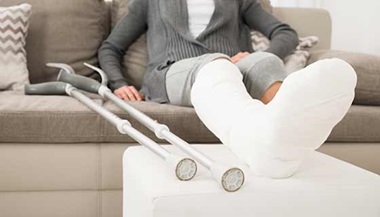Spondylolysis
What is spondylolysis?
Spondylolysis. Pars defect. Stress fracture. These three terms are used interchangeably, all referring to the same condition. Spondylolysis is a stress fracture through the pars interarticularis of the lumbar vertebrae. The pars interarticularis is a thin bone segment joining two vertebrae. It is the most likely area to be affected by repetitive stress. This condition is fairly common and is found in one out of every 20 people.
What are the symptoms of spondylolysis?
Spondylolysis doesn’t always have symptoms. When it does, the only symptom is usually back pain. The pain often gets worse with activity and sport, and is more notable when bending backward. Generally, the pain doesn’t interfere with everyday activities. If it persists, it is recommended to seek medical attention.
What are the risk factors for spondylolysis?
Being human and walking upright is the most basic risk factor for spondylolysis. The natural inward curvature of the lower back puts stress on the pars interarticularis. Certain sports that involve excessive or repetitive bending backward may increase the risk of spondylolysis. Examples include gymnastics, football and soccer. Young athletes may sometimes develop spondylolysis as a result of overuse and hyperextension of the lower back. Genetics could also be a risk factor for some people.;
Spondylolysis Diagnosis
If you have long-lasting, localized low-back pain, it could be due to spondylolysis. An X-ray is sometimes sufficient to defect a stress fracture. However, if pain persists despite rest and physical therapy, additional imaging may be necessary. Your doctor may need to order an MRI, a CT scan or a nuclear medicine bone scan with SPECT of the lumbar spine for a definitive diagnosis.
Spondylolysis Treatment
Spondylolysis treatment focuses on managing the pain and helping you return to your daily activities. This condition doesn't typically put you at risk for spinal cord injury or nerve damage.
Depending on the degree of pain, treatment options include:
- Rest/break from sports
- Nonsteroidal anti-inflammatory drugs
- Physical therapy for muscle strengthening and general conditioning
- A lumbar brace
Surgery to repair the fracture is rarely needed, as the pain is expected to fade over time in most cases.
Surgery for Spondylolysis
Surgery may be an option for adolescents with lumbar spondylolysis if other treatments have not helped. The fracture can be repaired by using a strong titanium screw. It is not a spine fusion. This surgery is done by making a 2- to 3-inch incision in the middle of the lower back. The screw is placed to secure the two sides of the fracture together, providing some compression across the area. Then a bone graft (a piece of bone from elsewhere in the body) could be used to further support the repair.
The surgery takes two hours, followed by one day in the hospital for recovery. Most adolescents will need to take one to two weeks out of school for recovery at home. Sports and rigorous exercises are restricted for three months after the surgery. This surgery is very successful in eliminating back pain related to spondylolysis. Most people are able to return to their previous level of sports and exercise without pain.
Your doctor may also recommend a surgical procedure such as spinal fusion if it’s found that spondylolysis has caused your vertebra to slip forward. This slippage is called spondylolisthesis, which is a different but related condition.


.png?h=170&iar=0&w=200&hash=59CEE2D9B28155C77CEEC18D1582DAE4)

.png?h=170&iar=0&mh=260&mw=380&w=200&hash=A5411087D582A22AA77E2C122660E28D)

